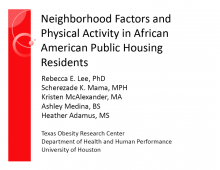We are pleased to announce an exciting new alliance between Active Living Research and GP RED to co-host and coordinate...
Neighborhood Factors and Physical Activity in African American Public Housing Residents - Presentation

Presentation at the 2010 Active Living Research Annual Conference
Background:
Many forms of physical activity (PA), such as walking, jogging or bicycling, are done in convenient places, like neighborhood streets. Public housing developments (HD) are typically located in lower socioeconomic status (SES) neighborhoods that may have poorer quality street level conditions, placing residents in neighborhoods that are less supportive for PA. Few studies have been able to capture this relationship, as segment characteristics that are hypothesized to be most influential require detailed auditing and analytic strategies to combine aggregated environmental characteristics with resident PA patterns. Public housing residents do not choose their home location and reside in approximately the same location as other neighborhood residents. Public housing residents are similarly exposed to the same environmental characteristics without selection bias, making public housing a unique opportunity to investigate the influence of neighborhood characteristics on human behavior.
Objectives:
This study investigated the relationships between street-level, pedestrian features and PA in African-American residents of low income HDs in Houston.
Method:
Neighborhoods (N=12) were defined as the area within an 800 meter radius surrounding each HD. Neighborhoods were mapped using GIS technology, and every street segment (N=2,093) was systematically assessed using the Pedestrian Environment Data Scan (PEDS). Variables measuring pedestrian traffic buffers, sidewalk connections, vehicle lanes, traffic speed limit, traffic control devices, amenities, and crossing aids were selected from the PEDS to represent pedestrian features. The total number of segments per neighborhood was counted as a measure of density. Variables were aggregated to the neighborhood level for ecologic analyses.
Residents from each HD were recruited on site via posted advertisements and face-to-face invitation to complete a multistage assessment. First, participants completed interviewer administered questionnaires assessing individual socio-demographics and the short form of the International PA Questionnaire (IPAQ) along with measured height and weight. Participants were given a take-home packet of additional questionnaires. Participants who returned one week later with the packet were given a pedometer to wear and asked to return one week later for pedometer return. Interviews, take-home packet return and pedometer return were incentivized with a modest sum of cash ($5-10 US) to enhance participation.
Results:
Residents (N=215, M=43.5 yrs, 64% female) were typically obese (M BMI = 31.3 kg/m²). Women reported significantly less vigorous (M=1,955 vs. 2,896 mets), moderate (M=733 vs. 1,309 mets), walking (M= 1,080 vs. 1,376 mets) and total (M=3,768 vs. 5,581 mets) PA on the IPAQ compared to men (ps<.05). Women took fewer pedometer steps (M=29,792 vs. 33,786) and expended fewer calories (M=1,209 vs. 1,463) compared to men (ps<.05). Bivariate analyses showed that age was inversely related to all IPAQ subscales (ps<.05), but not pedometer steps or calories. BMI was not associated with any PA measures. Vigorous PA was inversely associated with traffic speed. Moderate PA was associated with fewer segment buffers, fewer sidewalk connections, and a greater number of segments. Walking was associated with lower traffic speeds and having fewer crossing aids (ps<.05).
Ecologic analyses using simultaneous regression models were conducted separately by gender accounting for age and BMI using backward selection. For women, models that accounted for the most variance and were statistically significant suggested that lower speed limits were associated with vigorous PA (B=-.58, t=-2.083, p=.067); more segments were associated with more moderate PA (B=.410, t=1.740, p=.116); lower speed limits (B=-.888, t=-4.511, p=.003), fewer crossing aids (B=-.745, t=-2.138, p=.070) and more lanes (B=.761, t=2.055, p=.070) were associated with more walking; and, fewer lanes was associated with more overall PA (B=-.675, t=-2.854, p=.025). Fewer traffic control devices was associated with more total calories expended as measured by pedometer (B=-.732, t=-3.899, p=.004). For men, fewer sidewalk connections were associated with more moderate PA (B=-.665, t=-3.511, p=.007); lower speed limits (B=-.665, t=-3.511, p=.007) were associated with more walking; and, lower speed limits was associated with more overall PA (B=-.642, t=-2.647, p=.024). Fewer traffic control devices was associated with more pedometer steps (B=-.726, t=-2.983, p=.018) and more total calories expended (B=-.644, t=-2.382, p=.044).
Conclusions:
Neighborhood factors influence PA; in particular, lower speed limits appear most closely linked with walking for both men and women, consistent with previous research. Lower speed limits, and fewer crossing aids and traffic control devices suggests a higher proportion of residential streets, which may be safer for PA in urban settings. Differential relationships by gender imply gender specific PA patterns, differentially sensitive to street elements. Future research is needed to describe these relationships in detail and understand best how to strike a balance in promoting health both for women and men.
Support:
This project was supported by a grant from Robert Wood Johnson Foundation’s Active Living Research Program.
Related Tools & Resources
STAY UP TO DATE
RECENTLY ADDED TOOLS & RESOURCES
MOVE! A BLOG ABOUT ACTIVE LIVING
The "Active Living Conference" aims to break down research and practice silos and...







